
The Manners, Customs and Common Ways of Drinking Sake

In Sake drinking manners, there are "pourers" and "receivers".
Once this conduct is mastered, the bar will light up with beautiful men and women drinking Sake.

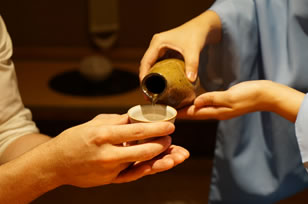
Before receiving the sake, drink what's left in the cup. By holding it in your right hand and supporting the base with your left, the sake cup will look beautiful to the pourer.
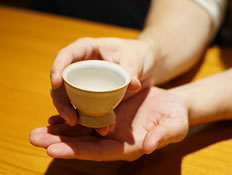
When having it poured, don't leave the base of the sake cup on the table. Be sure to hold it in your hand. Holding the cup in your right hand, support it with your left. If the base of the cup is elevated, you can hold it between the middle and ring fingers of your left hand.
Once you've been poured, it's good manners to first take a sip before placing the cup on the tabletop.

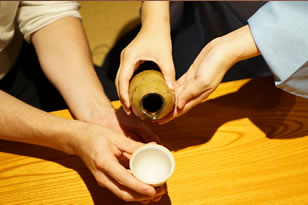
Holding the sake bottle firmly in your right hand, place your left hand near the mouth to support it.
When pouring, start with a trickle, move to a flow, and end with a trickle. In this way, you can control the strength or weakness of the pour. When you finish pouring, slightly turn the mouth of the sake bottle towards you to avoid dripping.
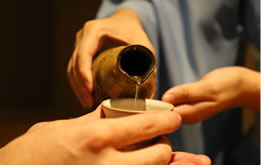
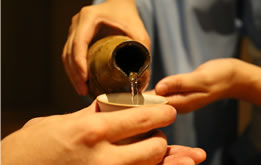
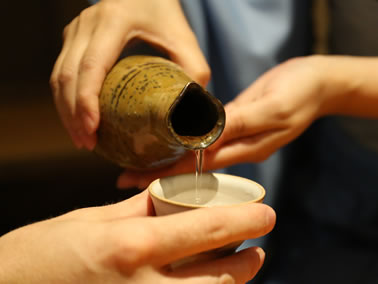
On a sake bottle, there is a part of the mouth that is pinched. When pouring, it's good manners to hold it upwards. By holding the thinly pinched part upwards, the Sake will drip down like a jewel, making a pretty image for the receiver. The pinched part is called "En no Kireme", which is a homophone for "cutting ties" in Japanese. That's one of the various opinions on why the pinched part is held upwards.


One of the charms of drinking Sake is the variety of Sake sets available. Made of glass or Japanese pottery or porcelain, you can match the drinking vessel to the situation or mood you're in. Depending on the vessel, the taste of the Sake may change. Since Sake sets have a deep connection with traditional Japanese handicrafts, it's fun to collect the ones you like!
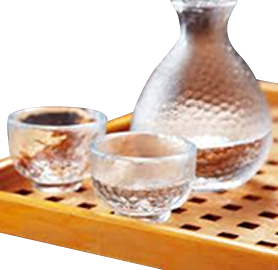
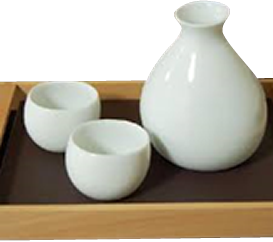
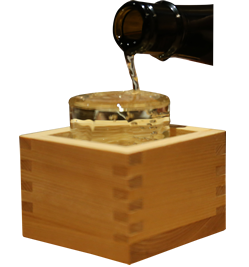


If you really want to enjoy Sake, remember a few manners. Do this, and you'll never be embarrassed. Here, I'll introduce a list of "Bad Sake Manners" that will be useful to know.

This means checking inside the sake bottle to see if there is any Sake left.
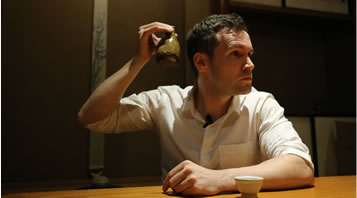
This means shaking the sake bottle to see if there's any Sake left. In the case of warming Sake containers, this will cause it to cool.
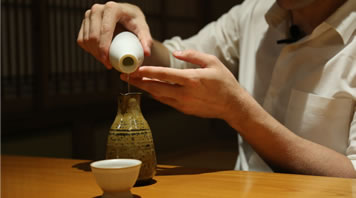
By gathering what's left of the Sake and pouring it into one sake bottle, the temperature and taste of the Sake will be affected.
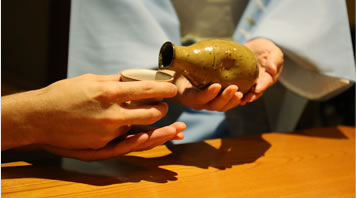
Facing the palm of your hand upward is believed to cause misfortune. This means holding the sake bottle with your right hand, supporting it with your left, and pouring for the person to your right, showing that person your wrist.
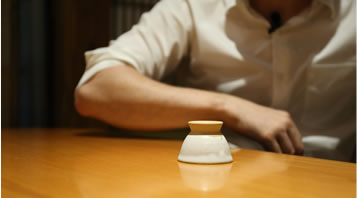
This means placing the cup upside-down on the table. Not only is this unsanitary, it also dirties the table.
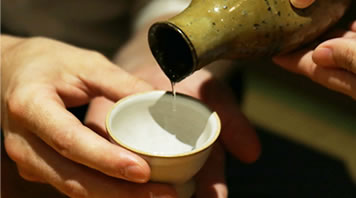
While it may seem good to pour the Sake to the brim of the sake cup or glass, it will be difficult to drink and may cause spills. This brings nothing but trouble to the receiver. On the other hand, there is the "Spillover" pouring style, where the Sake is poured to the brim of a glass that has been placed inside a "Masu" wooden box. If you want to offer your guest a lot of Sake, this is one way of doing it!

One feature of Sake is that it can be enjoyed at a variety of temperatures, and each of these temperatures has a special name. Please discover your favorite temperatures and flavors!
| Temperature (℃) |
Distinctive Japanese Names | Characteristics and Cautions | Compatible Types of Sake |
|---|---|---|---|
| Around 55 Degrees Celsius | "Tobikiri-kan" | At this temperature, the sake bottle will feel quite hot. It's suitable for "Hire-Zake", a hot sake filled with fish fins. When poured, the fins seem to "jump out" of the Sake, hence the name, "tobikiri". | Junmai-Shu, Honzojo-Shu |
| Around 50 Degrees Celsius | "Atsukan" | Hot to the touch, steam will rise from the sake bottle. The Sake will be dry, with a pleasant sharpness. | Honzojo-Shu |
| Around 45 Degrees Celsius | "Jokan" | The sake bottle will be somewhat cooler, but steam will rise when the Sake is poured from the bottle into the cup. Both the aroma and the flavor of the Sake will be bracing. | Junmai-Shu |
| Around 40 Degrees Celsius | "Nurukan" | When you drink it, this Sake will feel warm, and its sweetness and body will increase. | Ginjo-Shu, Junmai-Shu, Honzojo-Shu |
| Around 35 Degrees Celsius | "Hitohada-kan" | This Sake will feel lukewarm ("skin temperature" in Japanese) when drunk. Its "umami" will increase, leaving a smooth taste in the mouth. | Ginjo-Shu, Junmai-Shu, Honzojo-Shu |
| Around 30 Degrees Celsius | "Hinata-kan" | This will be a little higher than room temperature. If the Sake lacks flavor, it can be warmed up a little to bring out the aroma, creating a smooth taste. | Ginjo-Shu, Junmai-Shu, Honzojo-Shu |
| Around 20-25 Degrees Celsius | "Hiya" | This Sake is served at about room temperature, bringing out the original taste of the Sake. Please be careful to distinguish "Hiya" from "Hiya-Zake", which is cold. | Ginjo-Shu, Junmai-Shu, Honzojo-Shu |
| Around 15 Degrees Celsius | "Suzuhie" | This is Sake that has been taken from the refrigerator and set out at room temperature. When you drink it, this Sake will feel slightly chilled. | Ginjo-Shu, Junmai-Shu, Honzojo-Shu |
| Around 10 Degrees Celsius | "Hanahie" | This word, meaning "chilled flower" in Japanese, indicates different temperatures, depending upon the season. In summer, the Sake is served soon after being removed from the refrigerator. In winter, it's served at room temperature. As you drink, the flavor of the Sake will spread throughout the mouth. | Ginjo-Shu, Junmai-Shu, Honzojo-Shu |
| Around 5 Degrees Celsius | "Yukihie" | This name, meaning "snow-chilled" in Japanese, refers to the condensation that forms on the Sake bottle as it is removed from the fridge. To bring out its gorgeous flavors, this is best-suited to a fruity Ginjo Sake. | Namachozo-Shu, Taruzake, Ginjo-Shu |

This term is derived from a Chinese word meaning to drain your cup of Sake. This custom is said to have begun around the time of the Anglo-Japan Friendship Treaty, signed in 1854. At a banquet following the agreement, the Earl of Elgin introduced the custom of making a toast to the health of England's monarch. The samurai of the shogunate copied this custom, creating the first "Kampai" toast in Japan.

Familiar to Japanese is the long-standing custom of drinking this spiced Sake on New Year's Day to pray for good health and long life throughout the year.

"O-Miki" originated as the alcohol accompanying the food that was offered to the gods. In many places it means "Sake", but in Kyushu, Shochu may be offered instead. When "O-Miki" is offered to the gods during shrine visits or rituals, it is believed that spiritual power resides in the Sake, and by drinking it, this power may enter the body of the drinker.

From ancient times, cherry blossom trees have been regarded as lucky charms where the gods remain. This is said to be the origin of the custom of drinking Sake under the blossoms. There are other seasonal customs involving Sake, such as drinking it among the Japanese irises in May, drinking it to cool down in summer, drinking it while watching the full moon of autumn, or while watching the snow fall in winter.

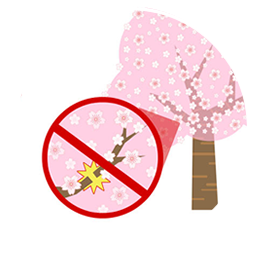
Don't break, bend or swing on the branches of the cherry trees, as this may damage them.
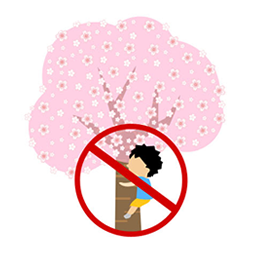
Please don't climb the cherry trees.
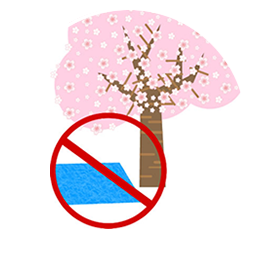
When laying out a plastic sheet to sit on, please place it away from the tree roots. If you step on the roots, the trees won't be able to breathe, and they may wither.
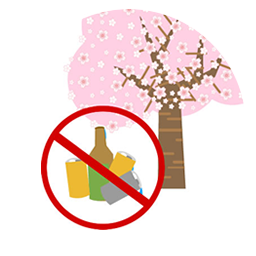
Don't pour the leftover drinks on the tree roots or on the ground. This will damage the roots and cause the trees to wither. Please dispose of them by pouring the liquid in a toilet or in a designated area.

Take away all of your garbage. If there is a place to throw it away, please separate it properly into the designated types.